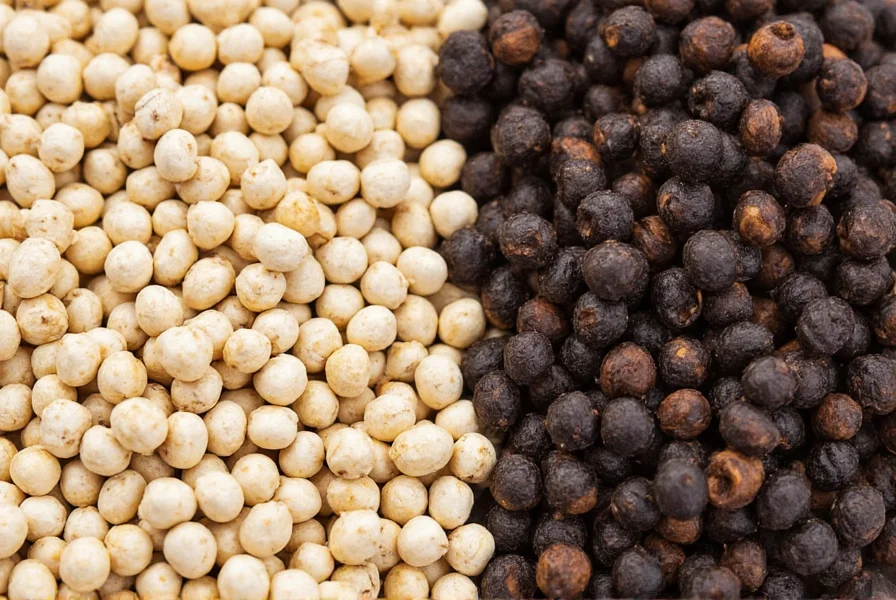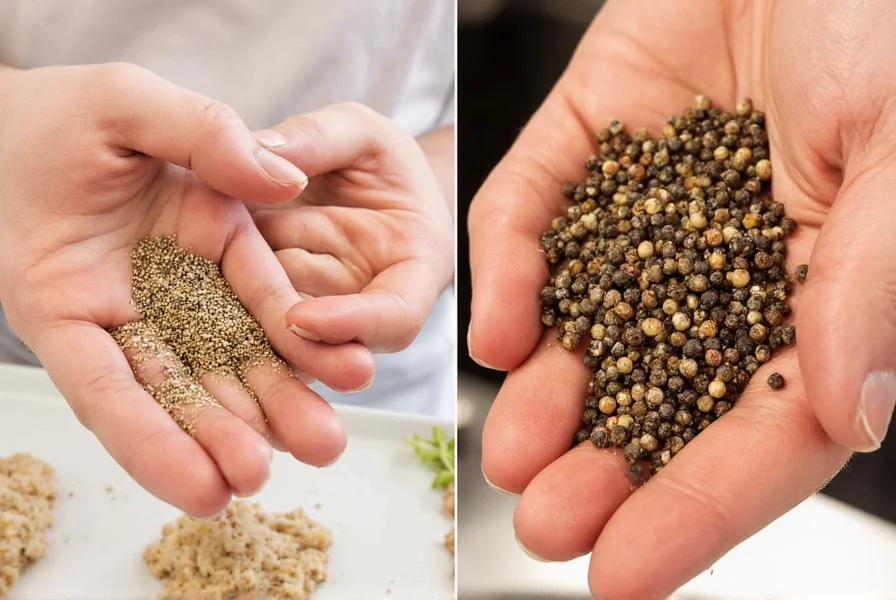Understanding the subtle yet significant distinctions between these two common spices can transform your cooking. Despite originating from the same vine, the harvesting and processing techniques create unique flavor compounds that serve different purposes in the kitchen. Let's explore these differences in detail to help you make informed choices for your culinary creations.
Origin and Processing Methods
Both white and black pepper come from the Piper nigrum plant, a flowering vine native to South India. The critical difference emerges during harvesting and processing:
Black pepper begins as green, unripe peppercorns. These are harvested and then sun-dried, which causes the outer layer (pericarp) to shrivel and turn black. This drying process triggers enzymatic reactions that develop black pepper's characteristic complex flavor profile with notes of pine, citrus, and floral elements.
White pepper starts as fully ripe red peppercorns. After harvesting, these are soaked in water for about a week, which ferments and softens the outer layer. The pericarp is then removed through rubbing or scraping, leaving only the inner seed, which is dried to become white pepper. This fermentation process contributes to white pepper's distinctive earthy, musty notes.
| Characteristic | Black Pepper | White Pepper |
|---|---|---|
| Harvest Stage | Unripe (green) | Ripe (red) |
| Processing Method | Sun-dried with outer layer intact | Soaked, outer layer removed, then dried |
| Flavor Profile | Robust, complex, floral, pine notes | Sharper, hotter, earthy, musty |
| Visual Impact in Dishes | Visible black specks | Virtually invisible |
| Common Culinary Uses | Most savory dishes, visible seasoning | Cream sauces, light-colored dishes, certain Asian cuisines |
Flavor and Aroma Comparison
When examining the difference between white and black pepper flavor, the contrast becomes immediately apparent. Black pepper offers a more complex aromatic profile with distinct top notes of citrus and pine, followed by a warm, pungent heat that builds gradually. The essential oil content in black pepper contributes to its more rounded flavor experience.
White pepper delivers a more direct, sharper heat that hits immediately with less complexity. Its flavor is often described as musty or earthy due to the fermentation process during production. This straightforward heat profile makes white pepper particularly useful when you want pure peppery heat without competing flavor notes.
Understanding when to use white pepper vs black pepper depends largely on the flavor profile you're trying to achieve. Black pepper's complexity complements dishes where you want the pepper to contribute to the overall flavor harmony, while white pepper works best when you need pure heat without visual distraction or competing flavors.

Culinary Applications and Traditional Uses
The visual difference between white and black pepper significantly influences their culinary applications. Black pepper's distinctive appearance makes it ideal for dishes where visible specks are desirable or expected, such as on steak, in dark sauces, or as a finishing touch on many savory dishes.
White pepper shines in applications where visual purity matters. Professional chefs frequently choose white pepper for:
- Cream sauces and soups where black specks would be visually disruptive
- Light-colored dishes like mashed potatoes, chicken dishes, or fish preparations
- Traditional Chinese cuisine, where white pepper is preferred for certain dishes
- Some European dishes like béchamel sauce or vichyssoise
Many professional kitchens maintain both varieties specifically to address different culinary needs. The difference between white pepper and black pepper in cooking extends beyond flavor to include visual presentation and cultural culinary traditions.
Nutritional Content and Health Considerations
Nutritionally, both peppers contain piperine, the compound responsible for pepper's heat and many of its health benefits. However, black pepper contains slightly higher concentrations of certain antioxidants due to the preservation of the outer layer during processing.
Some people find white pepper easier to digest than black pepper, though scientific evidence supporting this is limited. The fermentation process in white pepper production may alter certain compounds, potentially affecting digestion for sensitive individuals.
When considering the difference between white and black pepper nutrition, both offer similar benefits including improved nutrient absorption (particularly of turmeric's curcumin), antioxidant properties, and potential anti-inflammatory effects.

Storage and Shelf Life
Both varieties benefit from proper storage to maintain their flavor compounds. Whole peppercorns of either type retain their potency significantly longer than pre-ground versions. For optimal freshness:
- Store in airtight containers away from light and heat
- Keep whole peppercorns rather than pre-ground when possible
- Use within 1-2 years for maximum flavor impact
Ground white pepper tends to lose its potency slightly faster than ground black pepper due to the absence of the protective outer layer. This is another practical difference between white and black pepper that affects kitchen management.
Making the Right Choice for Your Dish
When deciding between white pepper vs black pepper, consider these factors:
- Visual presentation: Will black specks complement or disrupt the dish's appearance?
- Flavor complexity: Do you want the nuanced flavor of black pepper or the straightforward heat of white pepper?
- Cultural authenticity: Is one variety traditionally used in the cuisine you're preparing?
- Recipe requirements: Does the recipe specifically call for one variety over the other?
Many experienced cooks maintain both varieties in their spice collection, recognizing that understanding the difference between white and black pepper allows for more precise seasoning and better culinary results. The choice isn't about which is "better" but rather which serves the specific dish more effectively.











 浙公网安备
33010002000092号
浙公网安备
33010002000092号 浙B2-20120091-4
浙B2-20120091-4